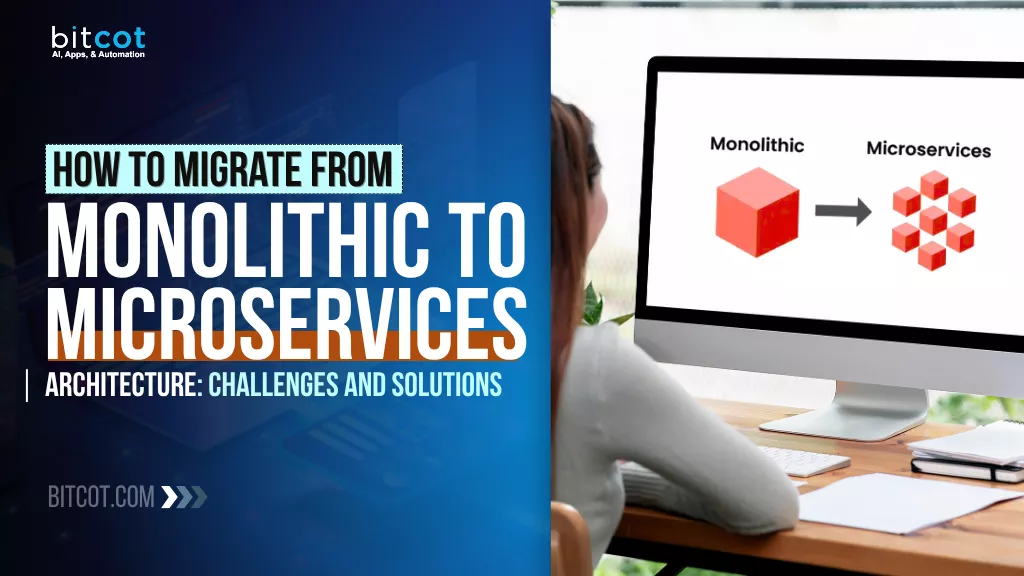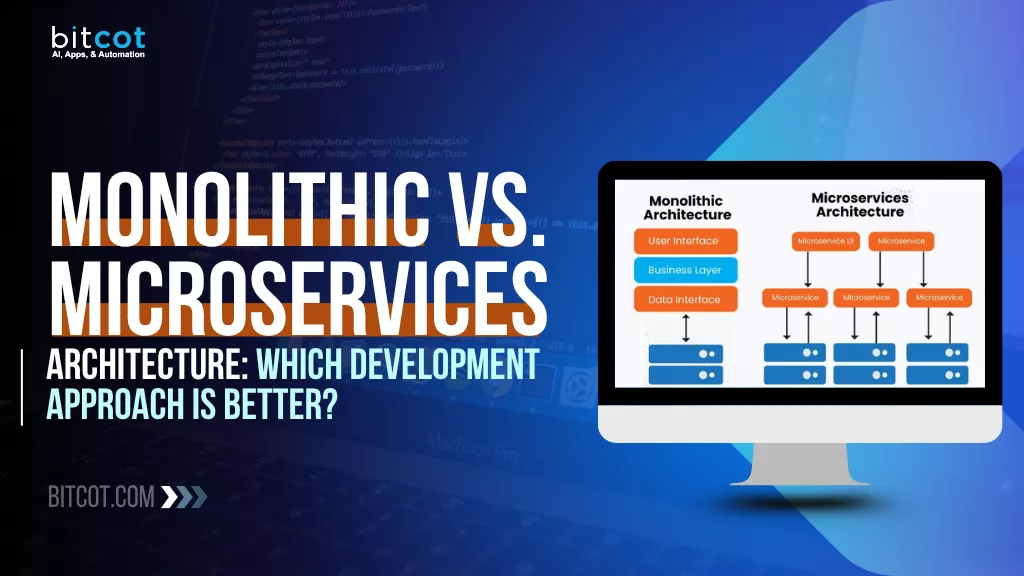
Your application is growing, your users want new features faster, and your engineering team is pushing hard to keep the system stable.
But when everything lives inside one massive codebase, every change feels risky. One update slows down deployments, one bug impacts the entire product, and one scaling issue becomes everyone’s late-night problem.
Sound familiar?
Modern products need flexibility: independent releases, faster innovation, and the ability to scale only what’s needed. When your architecture cannot keep up, you risk slowing the business down.
In this post, we’ll break down the practical steps to migrate from a monolithic architecture to microservices: what to expect, what to avoid, and how to move with confidence rather than chaos.
You’ll find real challenges teams face and clear solutions you can apply immediately.
Ask yourself:
- How long does it take to release a small feature?
- How often do teams step on each other’s code?
- How many performance issues come from parts of the app that shouldn’t even be affected?
You already know these pain points, but where are you on the path to fixing them?
Whether you’re a CTO, a product leader, or part of an engineering team, this transition is serious. Every delay in modernization is a delay in delivering value to your customers.
Microservices change that. They break complexity into manageable pieces, accelerate development, and give teams the autonomy to innovate without waiting on the entire system.
Bitcot helps teams make that shift. We build scalable, secure microservices architectures that unlock speed, stability, and long-term growth.
The future of software development is modular and agile. Are you ready to take the next step?
What is Microservices Architecture Migration and How Does It Work?
Microservices architecture migration is the process of moving from a traditional monolithic application to a system made up of many small, independent services.
Instead of having one large codebase that handles everything, each service in a microservices setup focuses on a single function. These services communicate with each other through APIs, which allows them to work together as one complete application.
To understand what makes this migration valuable, consider a few key advantages:
- Each service can evolve at its own pace.
- Teams can deploy updates without waiting for full system releases.
- Scaling is easier because only the services that need more resources are scaled.
- Issues in one service are less likely to bring down the entire application.
The core idea is to break a large, tightly connected application into smaller parts that can be developed, deployed, and scaled on their own. This makes it easier to update features, fix bugs, and roll out improvements without affecting the entire system.
So how does the migration actually work?
The process usually starts with identifying the pieces of the monolith that can be separated into standalone services. Teams often begin with the least risky or most frequently updated components.
Once a component is selected, it is rewritten or extracted as an independent service with its own codebase, database access, and deployment pipeline. After a service is created, the old version inside the monolith is gradually turned off, and traffic is routed to the new microservice.
Over time, more parts of the monolith are replaced, and the application becomes a fully distributed system. The transition takes planning, coordination, and strong communication across teams, but the end result is a more flexible and resilient architecture that can grow and adapt as the business evolves.
Why Migrate from Monolithic to Microservices Architecture and When to Do It
As applications grow and user expectations rise, many organizations start questioning whether their monolithic structure can keep up. Complex updates, slow releases, and scaling challenges often signal that it might be time for a different approach.
This is where microservices architecture enters the picture.
Before diving into the reasons and timing for migration, it helps to understand what makes microservices such a compelling alternative in the first place.
The Growing Pains of a Monolith: Why You Need a Change
When you’re a startup, a monolith is great. It’s simple to develop and easy to deploy. But as your business and codebase expand, that single, giant application starts causing serious problems. These are the key limitations that drive the need for microservices migration:
- Slower Development Velocity: Every time a developer needs to make a small change, they must deal with the entire, complex monolithic application. This leads to long build times, risky deployments, and slow feature release cycles.
- Inefficient Scaling Costs: To handle a traffic spike in just one area (like the checkout page), you have to scale the entire application architecture. This is a wasteful use of cloud resources and drives up your infrastructure bill.
- Technology & Framework Lock-in: The monolith is typically tied to a single, aging technology stack. Adopting a modern database or a high-performance programming language for a new feature is nearly impossible without a full, disruptive monolith rewrite.
- Poor Fault Tolerance: Because all services are tightly coupled, a failure or bug in one component can cause a cascading effect, potentially bringing down the whole system and leading to unacceptable downtime.
The Power of Decoupling: Core Benefits of Microservices
Microservices break down the application into specialized, self-contained services that communicate via APIs. This approach offers significant advantages for modern, high-growth systems:
- High Scalability and Efficiency: You can independently scale only the services that are under high load. This maximizes resource utilization and ensures efficient handling of massive user traffic without over-provisioning.
- Team Autonomy and Agility: Small, dedicated teams can own and develop their services independently. This fosters faster development, deployment, and significantly improves Continuous Integration/Continuous Deployment (CI/CD) pipelines.
- Technological Diversity (Polyglot Persistence): Each service can use the best technology stack for its specific job. One service might use Node.js for performance, while another uses Java for complex business logic, allowing for true innovation.
- Enhanced System Resilience: The architecture provides fault isolation. If one service fails, the others remain operational, ensuring a higher degree of fault tolerance and system reliability.
The Strategic Decision: When to Migrate from Monolithic to Microservices
Migrating a legacy system is a big commitment. You shouldn’t jump ship until the pains of the monolith outweigh the new operational complexities of a distributed system. The right time to start the architectural transformation is:
- When Development is a Bottleneck: If your company is missing market opportunities because the time-to-market for new features is too long due to the monolithic structure.
- When Costs Are Out of Control: Your cloud hosting costs are high because you are forced to scale the entire application for the load on a few small components.
- When Downtime Risk is Too High: The business absolutely requires high availability, and the risk of a single error taking down the entire system is an existential threat.
- When Using the Strangler Fig Pattern is Possible: The best way to transition is incrementally. Use the Strangler Fig Pattern to peel off one low-risk, high-value component at a time, implement it as a microservice, and route traffic to the new service before decommissioning the old code.
The best time to transition is when the pain of staying with a monolithic structure becomes greater than the effort required to break it apart. At that point, microservices offer a way to support faster growth, smoother deployments, and a more resilient system overall.
How to Migrate from Monolithic to Microservices Architecture in 3 Steps
So, you’ve decided the monolithic application has to go. Great! But how do you dismantle a massive, running system without causing chaos and outages?
The secret lies in one key strategy: incremental, low-risk change.
Here is a step-by-step guide on the process, centered around the most effective pattern for this transition: the Strangler Fig Pattern.
Step 1: Assess, Plan, and Restructure Teams
Before writing a single line of new code, you need a deep understanding and a clear strategy.
- Comprehensive Monolith Assessment:
▸ Mapping Dependencies: Use code analysis tools to map out all the call chains and dependencies between components. Identify the tightly coupled sections; these are the hardest to break apart.
▸ Identify Business Capabilities (Bounded Contexts): This is the most crucial step. Instead of technical layers (like a database or UI layer), break the system down by business function (e.g., ‘User Authentication,’ ‘Order Processing,’ ‘Product Catalog’). This approach, known as DDD, ensures the new microservices are truly independent. - Team Reorganization: Microservices demand autonomous, cross-functional teams where each team owns a small set of related services (their bounded context) end-to-end. Your organizational structure must align with the new architecture.
- Establish Foundational Services (DevOps/Platform): Moving to microservices requires a robust distributed infrastructure. You need:
▸ CI/CD Pipeline Automation: Automated testing, deployment, and rollback for every new service.
▸ Observability Tools: Centralized logging, distributed tracing, and monitoring to understand how requests flow across multiple services.
▸ Containerization: Use technologies like Docker and orchestration platforms like Kubernetes to manage the lifecycle and scaling of dozens of small services.
Step 2: The Strangler Fig Pattern in Action
The Strangler Fig Pattern is the recommended strategy for reducing risk during migration. It involves introducing a new service that “strangles” or gradually replaces a piece of the monolith’s functionality.
Phase A: The Facade (API Gateway)
- Introduce an API Gateway: Place a proxy or API Gateway layer in front of the monolithic application. All incoming requests from the frontend or clients must now pass through this gateway.
- Initial Routing: Configure the gateway to route 100% of the traffic directly to the existing monolith. It acts as a transparent pass-through layer for now.
Phase B: Isolate and Build the First Microservice
- Select the Candidate: Choose a non-critical, high-value component with the fewest external dependencies. A good candidate often benefits immediately from independent scaling (e.g., a reporting service or user profile lookup).
- Build the New Service: Develop the new microservice from scratch using modern technology. It must completely implement the chosen business capability. Leveraging full-stack development expertise ensures comprehensive coverage from frontend to backend.
- Implement the Anti-Corruption Layer (ACL): If the new service needs to read data still managed by the monolith, build a small translation layer (the ACL) to ensure the new service’s clean model isn’t “corrupted” by the legacy monolith’s data model.
Phase C: Strangling and Data Migration
- Shift Traffic (The Strangling): Update the API Gateway to route a small percentage (e.g., 5%) of the traffic for that specific business capability to the new microservice.
- Monitor and Validate: Use your new observability tools to monitor the new microservice’s performance and error rate against the old monolith. Canary releases and A/B testing are essential here.
- Tackle the Monolithic Database: This is often the hardest part. You must transition to a “Database Per Service” model.
▸ Step 1: The new microservice begins shadow writing to its own new database while continuing to write to the old monolithic database (for dual writes).
▸ Step 2: Migrate the historical data from the monolith to the new service’s database.
▸ Step 3: Once verified, the new service becomes the source of truth for its data domain. Any cross-service data needs must now be handled via events, message brokers, or APIs; never direct database access. - Incrementally Increase Traffic: Once stable, slowly increase the percentage of traffic routed to the microservice until it handles 100% of the load.
- Decommission: Once 100% of traffic is successfully routed and the new service is validated, the equivalent, redundant code in the monolith can be safely removed, and the legacy endpoint is decommissioned.
Step 3: Repeat and Scale
Repeat the process, one component at a time, moving to more complex and highly-dependent components as your team gains experience and confidence.
| Iteration | Component Complexity | Risk Profile | Focus Area |
| 1st | Low Dependencies, Simple Logic (e.g., Notifications) | Low | Build CI/CD, Master Observability, Team Learning |
| 2nd – 5th | Medium Complexity, High Value (e.g., Product Catalog) | Medium | Data Isolation (Database Per Service), Event Architecture |
| Final | High Dependencies, Core Logic (e.g., Payment Gateway) | High | Transaction Management (Sagas, Compensation Logic) |
This iterative approach minimizes risk, gives your team the necessary time to adopt new DevOps practices, and ensures the business remains operational throughout the entire application modernization journey.
Key Challenges and Solutions in Microservices Architecture Migration
Migrating from a monolith to a microservices architecture is a strategic journey, but it’s not without its bumps.
While the benefits of scalability and agility are clear, the distributed nature of microservices introduces a new set of technical and organizational complexities.
1. Data Management and Consistency
In the monolithic world, a single database enforces ACID transactions (Atomicity, Consistency, Isolation, Durability). In microservices, each service owns its data (Database Per Service), which complicates processes that span multiple services (like a purchase order).
- Challenge: Distributed Transactions. It’s hard to maintain data integrity when updates involve multiple, independent databases.
▸ Solution: Use the Saga Pattern. Break the transaction into a sequence of local transactions, where each step publishes an event to trigger the next. If a step fails, compensating transactions are executed to undo the prior work, ensuring eventual consistency. - Challenge: Data Synchronization. Services need to know about changes in other services’ data without directly accessing their databases.
▸ Solution: Embrace Eventual Consistency. Services communicate data changes via events using a message broker (like Kafka). During migration, utilize Change Data Capture (CDC) to monitor the monolith’s database and publish changes as events for new microservices to consume. - Challenge: Shared Data Access. The old monolith often relies on direct database access for everything.
▸ Solution: Resist the temptation to have multiple services write to the same legacy database table. Use the Anti-Corruption Layer (ACL) to translate data between the legacy monolith and the new service’s data model during the transition.
2. Operational Complexity and Observability
A monolith fails in one place; a microservices system can fail in hundreds. Managing, deploying, and monitoring dozens of independent services is exponentially harder than managing one.
- Challenge: Deployment and Scaling. Manually deploying and scaling many small services is overwhelming.
▸ Solution: Adopt Container Orchestration using platforms like Kubernetes. This automates deployment, scaling, self-healing, and network management for your entire service landscape, creating a standardized environment. - Challenge: Debugging and Tracing. A single user request may pass through ten different services, making it hard to find where an error occurred.
▸ Solution: Implement Distributed Tracing. Tools like Jaeger or Zipkin, often utilizing standards like OpenTelemetry, track a single user request across all the microservices it touches. This is essential for quickly locating bottlenecks or errors. - Challenge: Service Discovery. Services need to dynamically find and communicate with each other without hard-coding locations.
▸ Solution: Use a Service Registry (like Consul or Kubernetes’ internal DNS). Services must dynamically register themselves so that other services can find them by name.
3. Inter-Service Communication and Resilience
In the monolith, function calls are fast and reliable. In microservices, they become slower, unreliable network calls that can lead to cascading failures.
- Challenge: Network Latency/Failures. A dependency service going down can cause timeouts and failures across the entire system.
▸ Solution: Implement Resilience Patterns. Use the Circuit Breaker pattern to stop requests to a failing service immediately, preventing resource waste and timeouts. Implement Retries with Exponential Backoff for transient errors. - Challenge: Communication Strategy. Choosing between real-time requests and event-driven communication.
▸ Solution: Choose the right pattern: use Synchronous communication (REST/gRPC) for requests that require an immediate response (e.g., user login). Use Asynchronous communication (Message Brokers) for non-critical, long-running processes (e.g., order fulfillment, notifications). - Challenge: Security Across Services. Ensuring secure, authorized communication between dozens of components.
▸ Solution: Implement Zero Trust Architecture. Use an API Gateway to centralize authentication and authorization. Use JWTs (JSON Web Tokens) for services to securely pass user identity and permissions to each other.
4. Organizational and Cultural Shift
Microservices aren’t just a technical shift; they require your teams to change how they work, moving from centralized control to decentralized autonomy.
- Challenge: Team Structure & Ownership. The centralized, function-based team structure conflicts with the needs of autonomous microservices.
▸ Solution: Adopt the “You Build It, You Run It” philosophy. Restructure teams around business capabilities (e.g., the “Checkout Team” owns the Checkout service end-to-end), giving them autonomy over their technology stack, deployment, and operations. - Challenge: Skill Gaps. The team needs expertise in new distributed system concepts and operational responsibilities.
▸ Solution: Invest heavily in training for new distributed system concepts: event-driven architecture, Kubernetes, distributed tracing, and specialized testing. Encourage a DevOps culture where developers share operational responsibility. Consider partnering with an experienced digital transformation services provider to accelerate the learning curve.
While these challenges may seem daunting, they’re not insurmountable. With the right tools, processes, and mindset, organizations can successfully navigate their microservices migration and come out stronger on the other side.
Partner with Bitcot to Migrate from Monolithic to Microservices Architecture
Migrating from a monolithic architecture to microservices can feel like a huge undertaking, but you don’t have to do it alone.
Partnering with an experienced team like Bitcot can help you navigate the complexities and ensure a smooth transition. Whether you’re in the early planning stages or already starting to break down your monolith, Bitcot can guide you through every step of the migration journey.
At Bitcot, we specialize in transforming legacy systems into modern, scalable microservices architectures. Here’s why partnering with us makes sense for your migration:
- Expertise in Microservices: We have deep experience in designing and implementing microservices-based systems, with a strong understanding of the latest cloud technologies, frameworks, and best practices.
- Customized Strategy: No two migrations are the same. We’ll work closely with you to understand your current challenges, business goals, and future vision to design a migration plan tailored specifically to your needs.
- Seamless Integration: Our team ensures that the migration process doesn’t disrupt your day-to-day operations. We focus on minimizing downtime and maintaining the stability of your current system while gradually moving to microservices.
- Scalability & Flexibility: We help you build an architecture that scales with your business. Whether it’s adding new features, improving performance, or handling increased traffic, microservices enable agility and responsiveness to future needs. Our expertise in legacy application modernization ensures your transition is smooth and risk-free.
Migrating from a monolithic architecture to microservices doesn’t have to be overwhelming. By partnering with Bitcot, you’ll have a team of experts by your side, guiding you through every step of the process and helping you unlock the full potential of a modern, scalable system.
Final Thoughts
Making the leap from a monolithic to a microservices architecture is no small feat, but it can truly transform how your business operates.
With microservices, you’re not just breaking down your system into smaller pieces; you’re unlocking greater agility, scalability, and the ability to innovate faster. Yes, the migration process comes with its challenges, but with the right strategy, the right tools, and the right partners, it’s absolutely worth it.
If you’re feeling a little overwhelmed or unsure where to start, don’t worry; that’s where Bitcot comes in. We specialize in custom software development services that are tailored to meet the unique needs of your business.
Whether you’re looking to migrate your monolithic system to microservices or you need help optimizing your existing architecture, our team has the expertise to guide you through the entire process.
We’re here to make sure your migration is smooth, your system is scalable, and your business can continue to grow without hitting technical roadblocks.
So, if you’re ready to embrace the future of software architecture, reach out to Bitcot today, and let’s discuss how we can help you take your business to the next level.












